Want to give your garden a bold, stylish twist that turns heads and sparks conversation? Try going monochrome! A black and white garden isn’t just trendy—it’s timeless. The crisp contrast between dark, velvety blooms and bright, snow-white flowers brings a whole new level of elegance to your outdoor space. Whether you’re working with a small backyard, a balcony container garden, or a sprawling flower bed, this dramatic color scheme works in every size and setting. And the best part? It’s totally DIY-friendly!
In this easy-to-follow guide, we’ll walk you through 25 real black and white flowering plants — no artificial dyes or gimmicks here. You’ll discover a mix of stunning white blooming perennials, mysterious black-toned annuals, and a few surprises that bring the palette to life. For each plant, we’ll include the common name, Latin name, and practical care tips covering sunlight requirements, soil preferences, and watering needs, so you can plant with confidence and avoid rookie mistakes.
If you’re new to gardening, don’t worry—we’ve got you. This guide includes low-maintenance picks and hardy classics that thrive in various climates and soil conditions. If you’re more of a seasoned green thumb, you’ll still find plenty of inspiration to create a garden design that’s both modern and moody, crisp and classic.
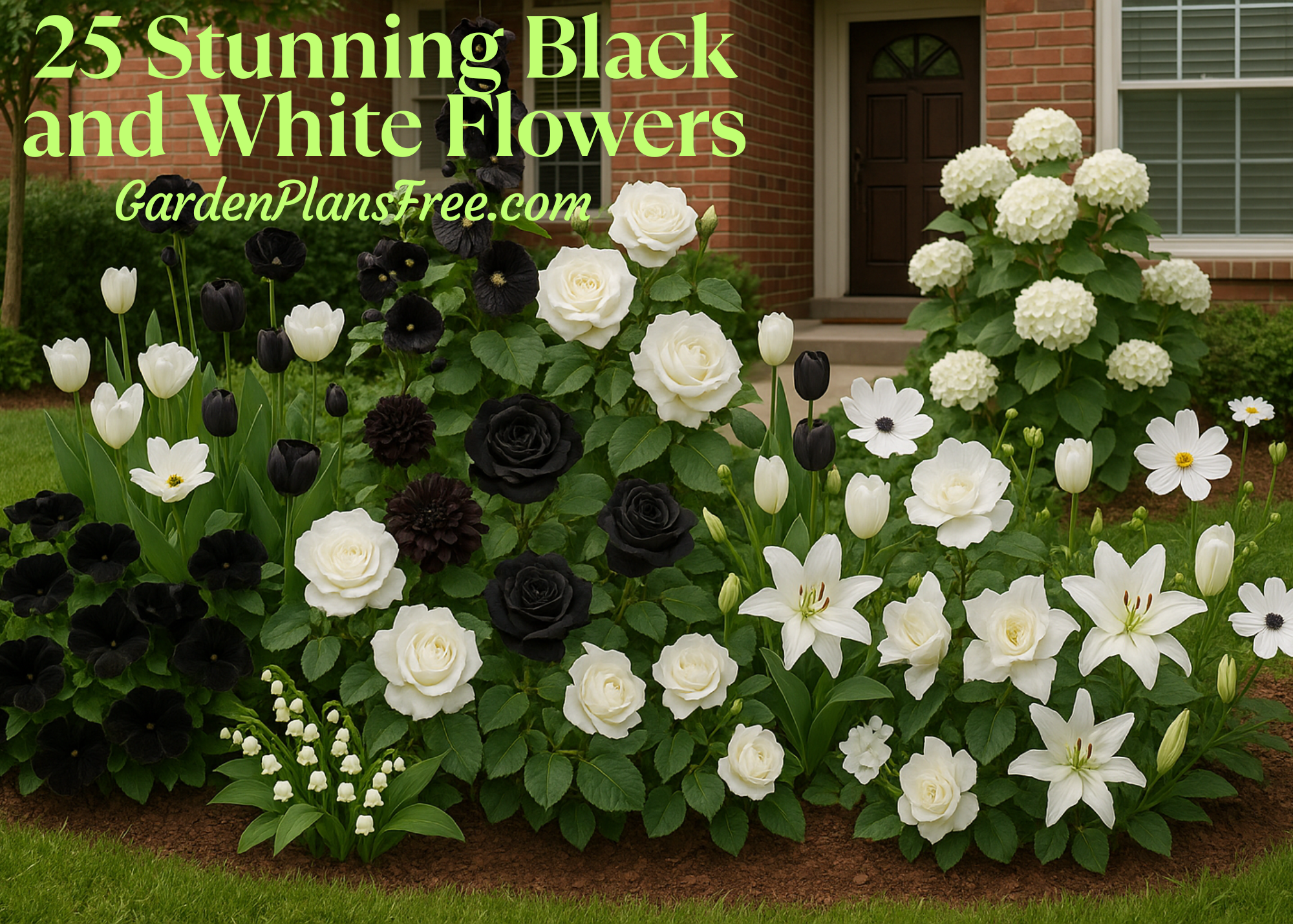
From the inky petals of a Black Velvet Petunia to the glowing brilliance of a White Coneflower, this curated list of plants will help you create a garden that’s equal parts artistic and inviting. These flowers aren’t just beautiful—they attract pollinators, boost curb appeal, and give your landscape a signature look that feels both refined and adventurous.
So grab your gloves and a shovel—it’s time to design your own black and white botanical escape. Let’s dive in, get inspired, and start planting a garden full of contrast, character, and creativity!
Black Beauties: Dramatic Dark Flowers
1. Black Velvet Petunia (Petunia hybrid)
Description: Arguably the world’s first true black petunia, ‘Black Velvet’ bears velvety, jet-black trumpet-shaped blooms. It’s an annual perfect for containers or bedding, pairing beautifully with whites or bright colors. Despite its exotic look, it’s as easy to grow as any other petunia.

Light & Soil: Give black petunias plenty of sun – at least 6 hours of direct sunlight for best flowering. They perform well in average, well-drained soil; good drainage is important to prevent rot. Petunias don’t need extremely rich soil, but mixing in a bit of compost helps.
Water & Care: Water regularly, keeping the soil moist but not waterlogged. Petunias appreciate consistent moisture, but let the top inch dry out slightly between waterings to avoid sogginess. Feed with a balanced, bloom-boosting fertilizer every few weeks to keep those blooms coming. Also, deadhead (pinch off spent flowers) to encourage continuous blooming. With full sun and basic care, Black Velvet petunia will reward you with masses of deep, dramatic blossoms all summer.
2. ‘Queen of Night’ Tulip (Tulipa ‘Queen of Night’)
Description: This famous late-spring tulip sports deep maroon-purple petals so dark they appear black. ‘Queen of Night’ is a tall, single late tulip that adds drama to any spring bulb display. Plant it with pure white tulips for a classic black-and-white combo.

Light & Soil: Like most tulips, it thrives in full sun and organically rich, well-drained soil. Good drainage is crucial – tulip bulbs can rot in waterlogged soil. If you have heavy clay, consider raised beds or mix in sand/compost to improve drainage.
Planting & Water: Plant ‘Queen of Night’ bulbs in the fall, about 4–6 inches deep and a few inches apart. They prefer cool, moist winters and warm, dry summers (the classic pattern for tulip success). Water the bulbs in after planting and keep soil moderately moist in spring as they grow. Once blooming is done, you can taper off watering as the foliage dies back.
Care Tips: Many gardeners treat hybrid tulips as annuals – enjoy the spectacular spring show, then replant fresh bulbs next fall. Tulips often decline after the first year, so don’t be discouraged if ‘Queen of Night’ comes back weaker; this is common (many growers simply replant each year for best results). For perennializing, allow the foliage to fully yellow and wither before removing – this helps feed the bulb for next year. In any case, the near-black blooms of this tulip are worth every effort!
3. Black Hollyhock (Alcea rosea ‘Nigra’)
Description: An heirloom favorite, ‘Nigra’ hollyhock produces tall spires (5–8 feet) of single flowers in a dark maroon so deep it looks black. These cottage-garden classics bring vertical interest and an old-fashioned charm. They’re short-lived perennials or biennials, but often self-seed to return year after year.
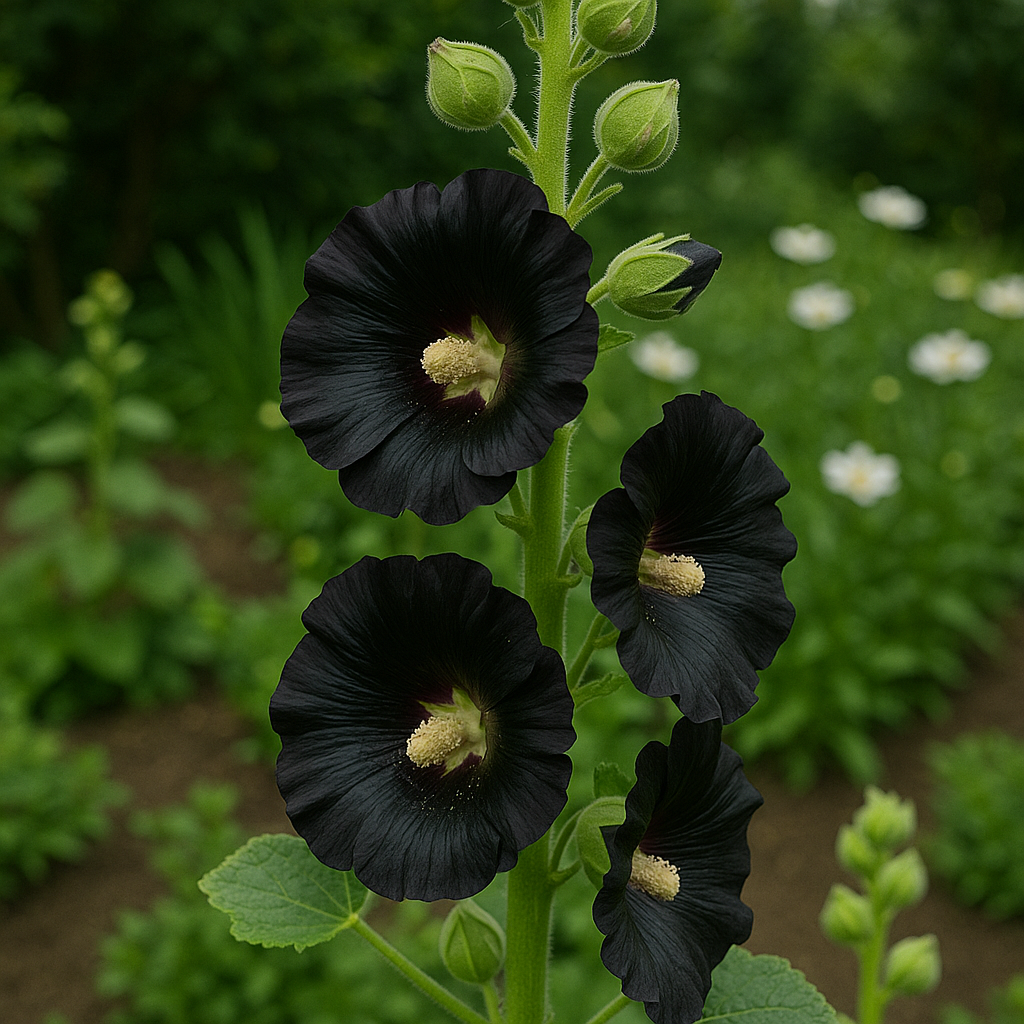
Light & Soil: Plant black hollyhocks in full sun for best blooming. They tolerate a wide range of soils – even not-so-rich soil – as long as it’s well-drained. Wet, boggy winters can kill the plants (the roots dislike sitting in water), so ensure drainage is good. They’ll even handle clay or poorer soil if it isn’t waterlogged.
Water & Care: Provide medium moisture – basically, average garden watering is fine. Hollyhocks like consistent moisture but can handle short dry spells once established. Avoid soaking the foliage if possible to reduce rust disease. These tall plants may benefit from staking or planting near a fence for support, especially in windy areas (their towering stems can flop in strong winds). Remove spent flower spikes to tidy up, and let some seed pods mature if you want them to reseed. Hollyhocks often self-sow, forming natural colonies that give the appearance of a perennial stand. With their almost-black blooms and impressive height, ‘Nigra’ hollyhocks make a dramatic backdrop in any garden.
4. Black Pansy (Viola x wittrockiana ‘Black Magic’ or ‘Black Beauty’)
Description: Believe it or not, pansies come in near-black! Black pansies (sometimes sold as ‘Black Magic’, ‘Black Beauty’, or ‘Molly Sanderson’ viola) have velvety petals of deepest purple-black. These low-growing, cool-season annuals (or short-lived perennials) are perfect for edging, containers, or early-spring flower beds. They add an unexpected dark accent and pair nicely with white violas or dusty miller for contrast.
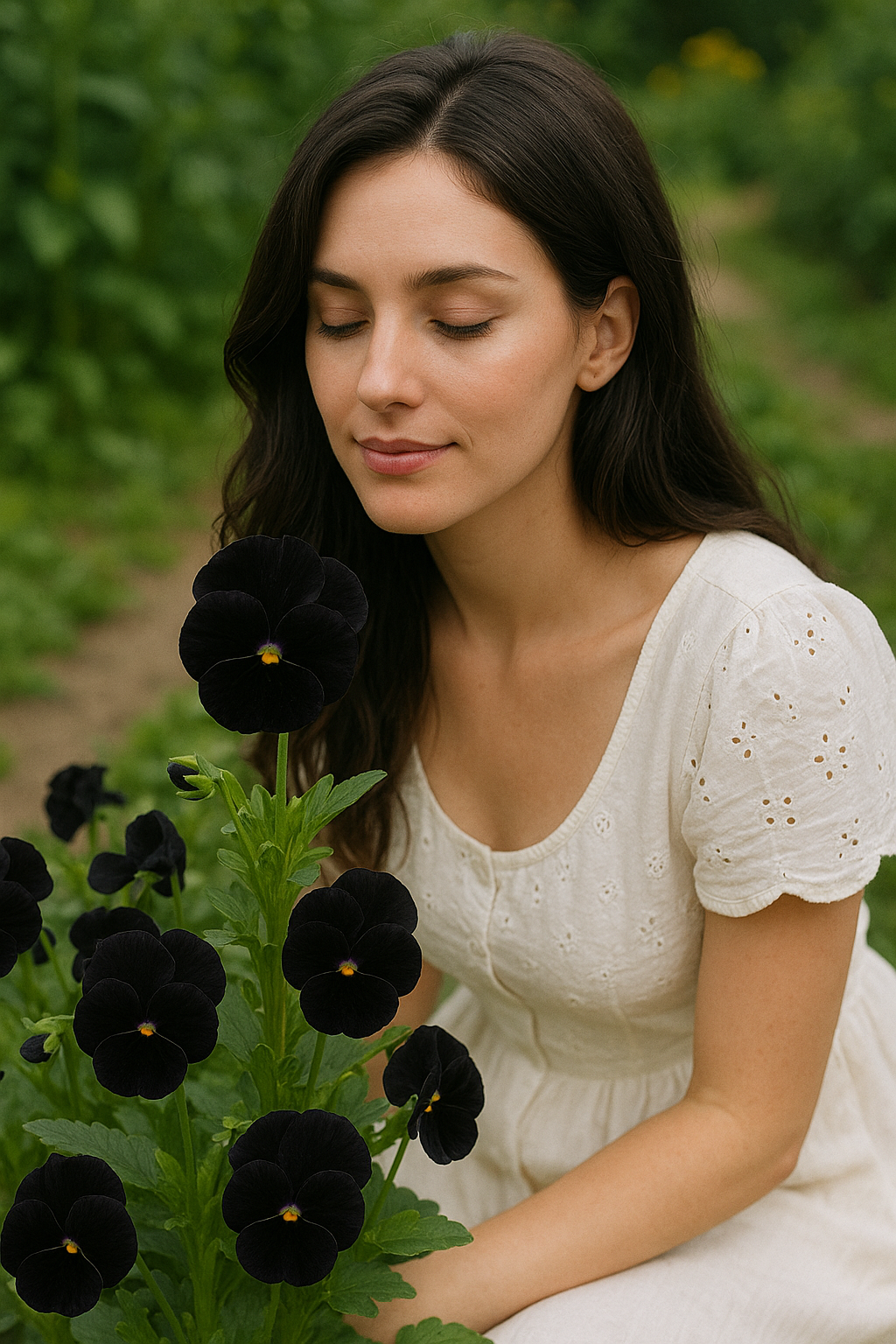
Light & Soil: Full sun to partial shade is ideal for pansies. In cool spring or fall weather, full sun promotes more blooms; but as temperatures warm, partial afternoon shade helps extend their bloom season. Plant in loose, rich soil that drains well, as pansies like moisture but hate soggy roots. A soil high in organic matter (humus or compost) works great since pansies are “heavy feeders” and appreciate fertility.
Water & Care: Keep soil consistently moist but not waterlogged. Pansies prefer evenly moist conditions; if they dry out, they’ll stop blooming. Water whenever the top inch of soil feels dry, especially in sunny spots. These cool-loving flowers thrive in spring and fall – if summer heat arrives, give them some shade and water to help them hang on. Deadhead spent blossoms to encourage continuous bloom. With regular watering and a little fertilizer every few weeks, your black pansies will carpet the garden with their charming, gothic “faces.” They’re an easy, rewarding choice for monochrome planting, providing true black blooms in the cooler seasons.
5. Bat Flower (Tacca chantrieri)
Description: For the adventurous gardener, the tropical black bat flower is a conversation-starting exotic. Its bizarre blooms have wing-like black bracts and long, whisker-like filaments, looking just like a bat in flight! This is a specialty plant (native to Southeast Asia) often grown as a houseplant or in tropical shade gardens. It requires a bit of extra care, but its truly black flowers make it one-of-a-kind.
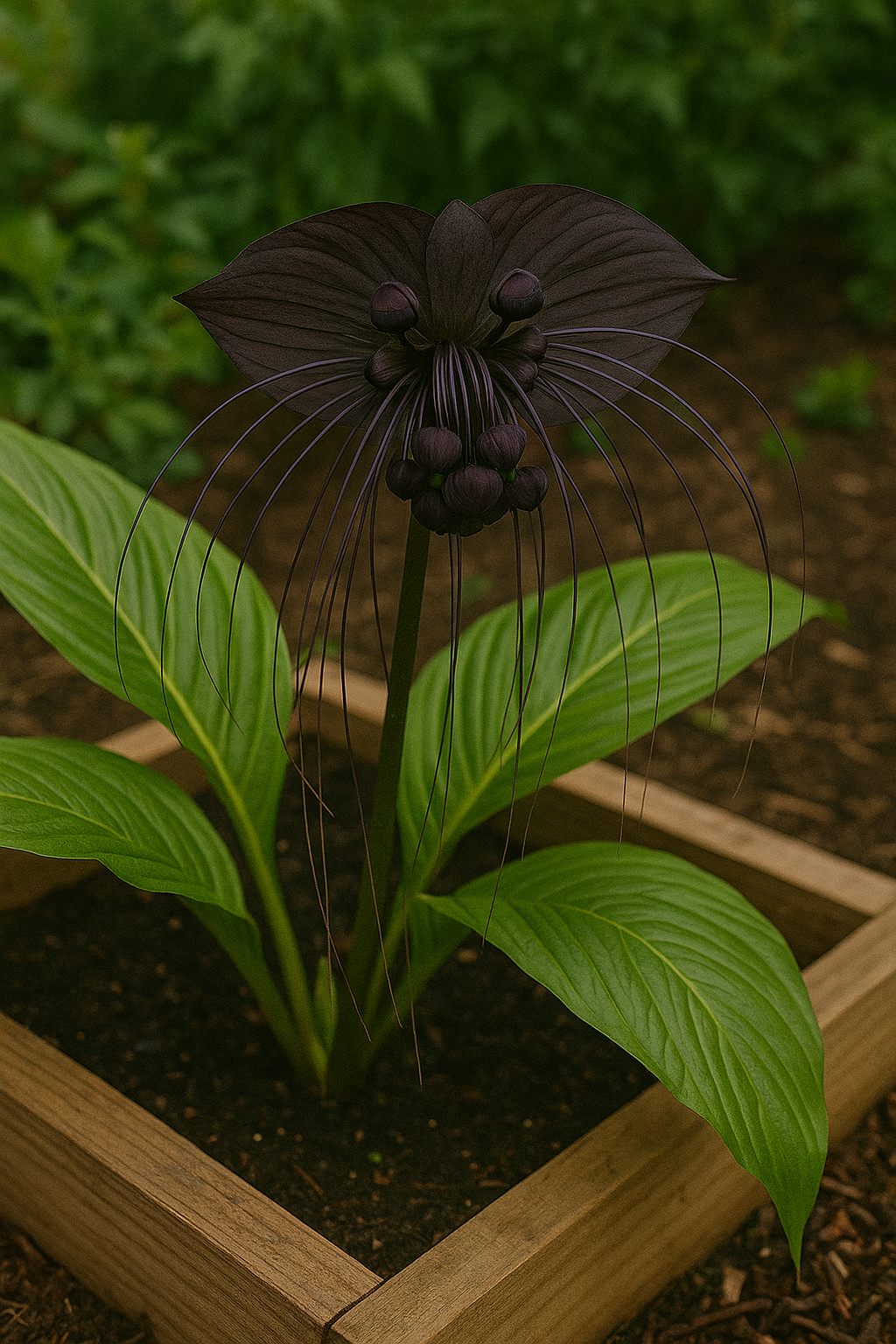
Light & Humidity: Bat flower prospers in low to moderate light – think bright indirect light or dappled shade similar to orchid conditions. Outdoors, keep it in full shade (no direct sun on those leaves). It absolutely loves humidity – aim for 50–70% humidity if possible. (Indoors, you can mist it or place the pot on a pebble tray with water.) Good air circulation is also important to mimic its jungle understory habitat.
Soil & Water: Use a rich, well-draining potting mix – similar to an orchid mix. A recommended medium is one with lots of organic matter (e.g. pine bark and peat) and sand/perlite for drainage. The soil should be kept evenly moist at all times. Water consistently so the soil never fully dries out, but also ensure excess water drains away – bat flowers do not like waterlogged roots. They are warmth-loving (65–85 °F ideal) and frost-tender, so if you’re not in a tropical climate, grow it in a pot that you can bring indoors for winter.
Care Tips: Bat flowers are finicky but rewarding. Feed lightly with a balanced or orchid fertilizer during the growing season (they respond well to regular, diluted feeding). They may bloom multiple times a year when happy. Place the plant in a wide, shallow pot to accommodate its roots, and repot only when root-bound. With ample humidity, warmth, and shade, your bat flower can thrive and produce its otherworldly black blooms – a sure wow-factor in any black-and-white plant collection.
6. Chocolate Cosmos (Cosmos atrosanguineus)
Description: Don’t be fooled by the name – this isn’t a chocolate plant, but it does smell like one! Chocolate cosmos bears velvety deep maroon-brown blossoms that give off a cocoa scent on warm days. Often called a “black cosmos,” it’s a summer-blooming tender perennial (often grown as an annual) reaching about 2–3 feet tall. The daisy-like flowers and airy foliage make it a lovely cottage-garden plant, great for borders or cutting gardens.
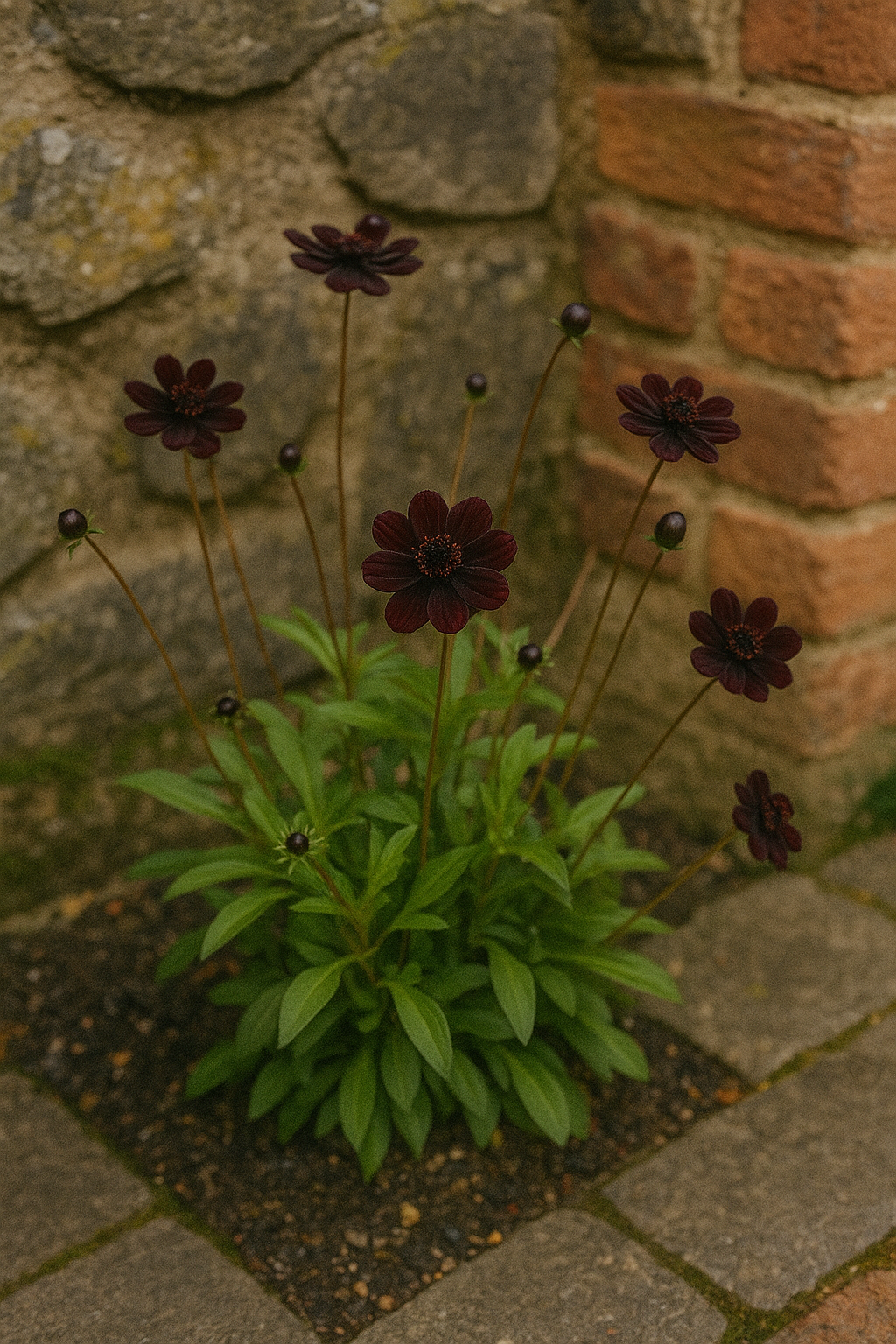
Light & Soil: Plant chocolate cosmos in full sun for best flowering. They enjoy sun and warmth, much like their more common pink cosmos cousins. Soil should be average and well-drained – they do not like heavy, waterlogged soil. In fact, they tolerate dry or sandy soils well and don’t need particularly rich ground; moderately fertile soil is plenty. Good drainage is especially crucial because this plant grows from tuberous roots that can rot in wet conditions.
Water & Care: Provide moderate water – cosmos are fairly drought-tolerant once established and prefer it on the drier side rather than too wet. Let the topsoil dry out between waterings. Being native to Mexico, Cosmos atrosanguineus enjoys heat and can handle periods of dryness (though it will flower more with regular moisture). Deadhead the faded blooms to encourage continuous flowering through summer. In cold climates (below USDA zone 7), you’ll need to treat it as an annual or dig up the tubers before frost. Lift the tubers in fall and store them like dahlia tubers – in a cool, dry spot – and replant in spring. If you’re looking for a nearly black flower that’s also fragrant, chocolate cosmos is a delightful pick – imagine dark blooms that smell like chocolate!
7. Black Bearded Iris (Iris germanica – dark cultivars e.g. ‘Before the Storm’)
Description: Bearded irises come in a rainbow of colors, including some stunning near-blacks. Varieties like ‘Before the Storm’, ‘Superstition’, or ‘Black is Black’ feature sumptuous black-purple petals on classic iris flowers. These perennials have sword-like leaves and bloom in late spring. A clump of black irises makes a dramatic statement, especially paired with white irises or peonies.
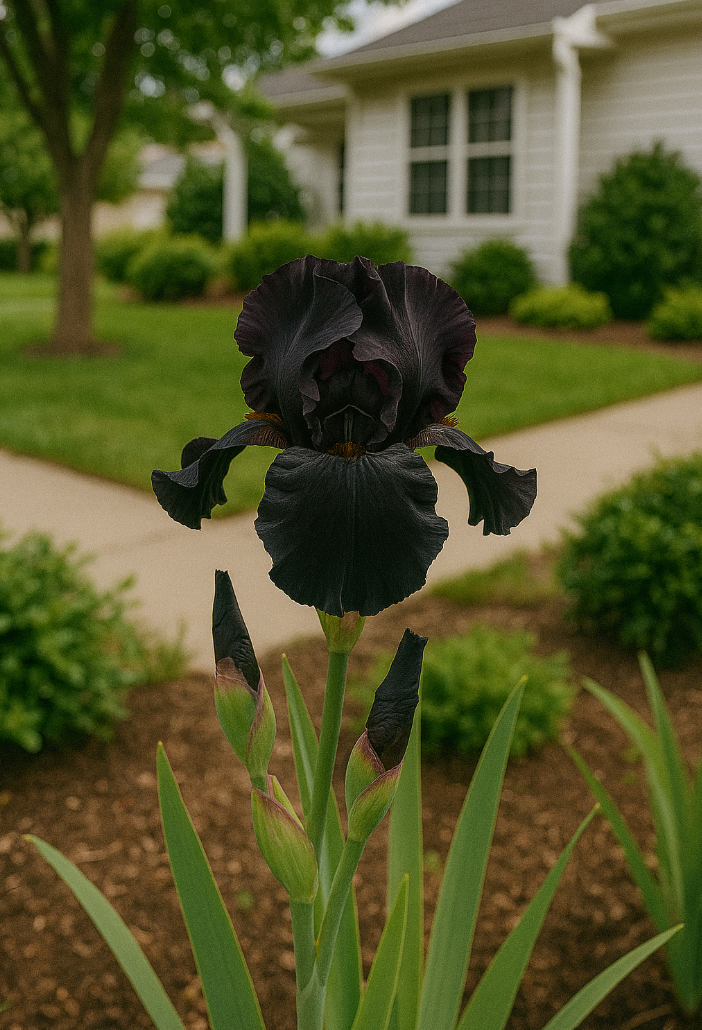
Light & Soil: Plant bearded iris in full sun for best bloom; they can tolerate a little afternoon shade in hot climates, but at least 6 hours of sun ensures vigorous flowering. Use well-drained soil – this is critical, as iris rhizomes (the thick root-like stems) will rot in waterlogged soil. If you have heavy soil, consider raised beds or adding grit to improve drainage. Iris actually prefer a neutral to slightly alkaline soil, and average fertility is fine (too rich a soil can lead to rot or excess leafy growth).
Water & Care: Medium moisture is ideal. In practice, this means regular watering during active growth (spring into early summer), then a bit drier in summer when they’re dormant. In fact, bearded irises are quite drought-tolerant once established – they evolved in summer-dry climates. Water them consistently from spring through flowering (they appreciate moisture during bloom time), then you can ease up. Make sure water doesn’t sit around the rhizomes. It’s often recommended to plant iris rhizomes shallowly, with the top just peeking above the soil, to prevent rot. Also, ensure good air circulation around plants. Every few years, if the clump gets crowded and blooms decrease, dig and divide the rhizomes (usually in late summer) to reinvigorate them. Other than that, these black irises are fairly low-maintenance. Their almost gothic blooms are sure to turn heads in your monochrome garden!
8. Black Dahlia (Dahlia – dark varieties like ‘Arabian Night’)
Description: Dahlias are beloved for their spectacular flowers in late summer and fall – and some cultivars come in very dark hues. ‘Arabian Night’, for example, is a dahlia with deep red-black double blooms. Other dark dahlias include ‘Black Beauty’ or ‘Tamburo’. These are tuberous perennials (treated as annuals in cold zones) that produce abundant blooms from midsummer until frost. A black dahlia in bloom looks almost like a living velvet pom-pom – a true showstopper in the garden or vase.

Light & Soil: Dahlias thrive in full sun (at least 6–8 hours of sun daily) for strongest stems and best flowering. They also like rich soil – organically rich, well-drained soil is ideal. Before planting, amend your soil with compost or well-rotted manure to provide nutrients. Good drainage is important because dahlia tubers can rot in soggy soil.
Water & Care: Consistent moisture is key for dahlias – they have a big thirst when actively growing and blooming. Water regularly to keep the soil evenly moist (but not muddy). During the heat of summer, a deep watering a couple times a week is usually needed. Do not let the soil dry out completely, as drought stress can reduce flowering. Tall dahlia varieties will likely need staking – place a stake at planting time and tie the stems as they grow to prevent them toppling (especially those with giant blooms). Dahlia plants also appreciate a low-nitrogen fertilizer (like a 5-10-10) every month or so to boost blooms. Deadhead spent flowers to encourage more buds. In cold climates (zones 7 and colder), remember to lift and store the tubers after the first frost. Store them in a cool, dry place over winter and replant in spring. With a little care, your black dahlias will provide a bounty of dramatic blooms and become a highlight of your late-season garden.
9. Black Hellebore (Helleborus hybrids, e.g. Lenten Rose ‘Black Diamond’)
Description: Hellebores, often called Lenten roses or Christmas roses, are shade-loving perennials that bloom in late winter to early spring. Breeders have developed some near-black varieties such as ‘Black Diamond’, ‘Onyx Odyssey’, or ‘Dark and Handsome’ which feature dusky purple-black petals. These nodding cup-shaped flowers add a touch of mystery to shady gardens, and the plants have attractive evergreen foliage. Hellebores are also long-lived and deer-resistant, making them a great low-maintenance choice.
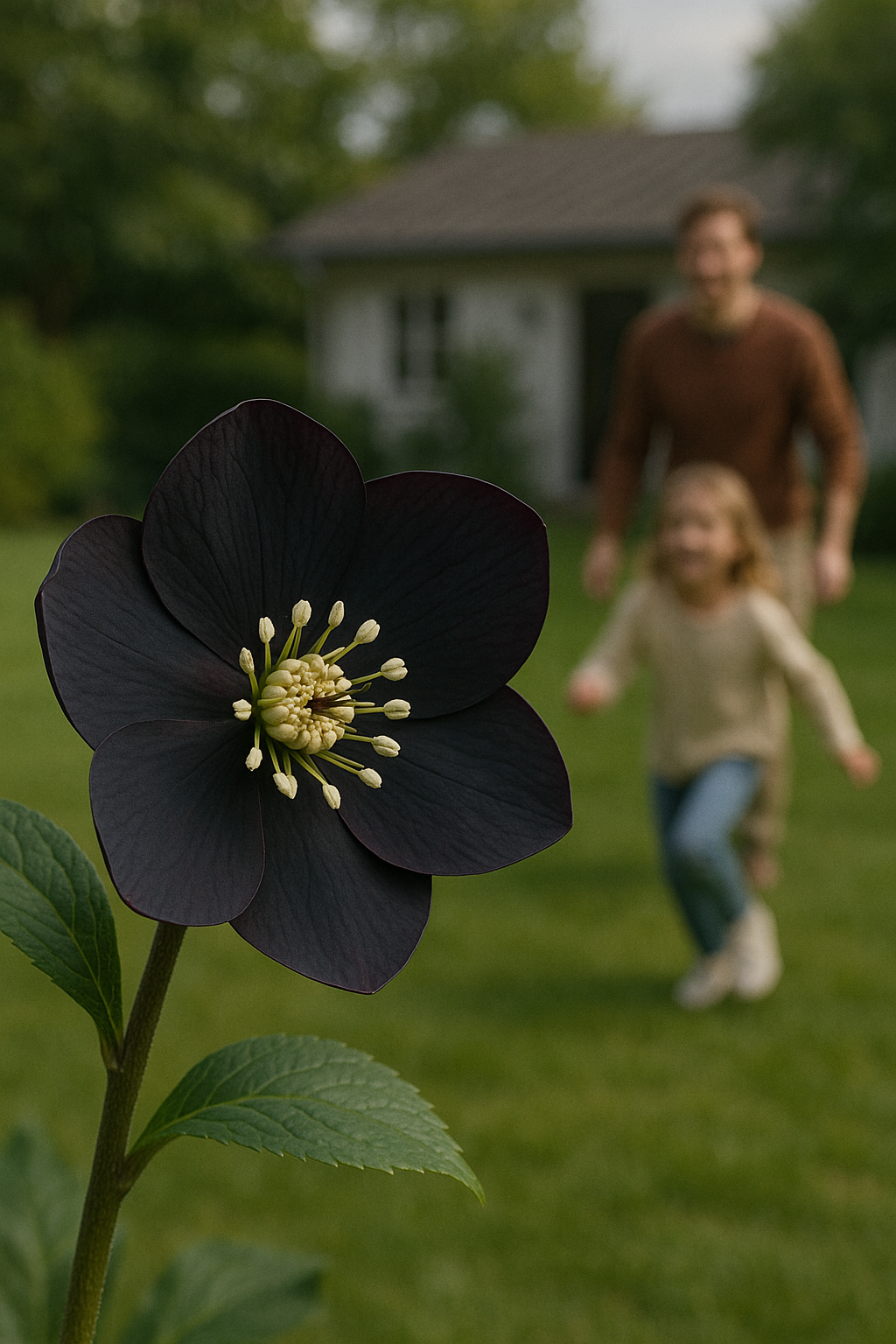
Light & Soil: Plant black hellebores in a partial to full shade location – they thrive under the dappled light of deciduous trees or on the north side of the house. Avoid intense afternoon sun, especially in summer, as it can stress the plant (and bright winter sun can scorch leaves). Use organically rich, well-drained soil; hellebores love humus-rich woodland type soil. Work in compost or leaf mold when planting to mimic their natural conditions. They prefer neutral to slightly alkaline soil, but are fairly adaptable as long as it’s not extremely acidic.
Water & Care: Hellebores like even moisture – keep soil moderately moist, especially during their growing/bloom season (late winter through spring). They can handle drier periods in summer once established, but don’t let them bake in drought if possible. These plants are quite hardy (many are zone 4–9) and low-maintenance. Simply remove old tattered leaves in late winter before the new flowers and foliage emerge for a cleaner display. Otherwise, you can pretty much “plant it and forget it.” They will slowly form clumps. After flowering, you can trim off the old flower stems. Hellebores often self-seed around the plant if happy. With their moody dark blooms and evergreen leaves, black hellebores are perfect for adding year-round interest to a shady monochrome garden. (Note: All parts of hellebores are poisonous, which is actually a plus for gardeners – it means they’re deer and rabbit resistant!)
10. Black Calla Lily (Zantedeschia hybrids – e.g. ‘Black Star’)
Description: Calla lilies are elegant plants known for their trumpet-like flower spathes. Some modern hybrids come in near-black shades; for instance, ‘Black Star’ or ‘Black Forest’ calla lilies have deep purple-black blooms. The contrast of a black calla lily against its glossy green leaves (and against white companions) is truly striking. Callas grow from rhizomes and are often used in containers or annual beds in cooler zones (perennial in mild climates).
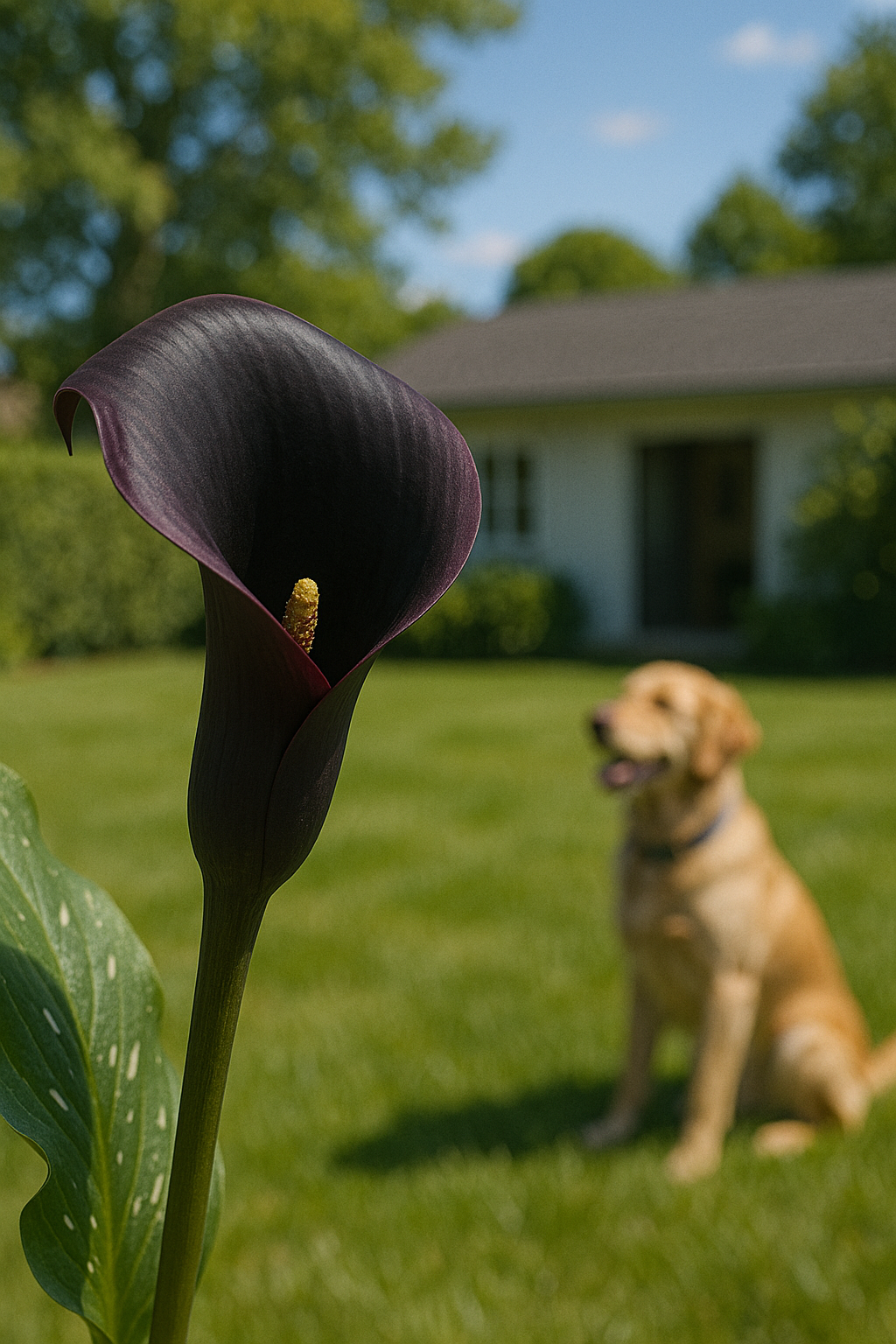
Light & Soil: Calla lilies prefer full sun to partial shade. In cooler summer regions they do well in full sun, but in hot climates it’s best to give them some afternoon shade to prevent leaf scorch. They definitely appreciate bright light overall. Soil should be rich and well-draining. These are bog-edge plants in the wild, meaning they like moisture but in soil that drains – not standing water. A loamy soil with plenty of organic matter (compost or peat) is ideal. If your soil is heavy clay, lighten it with compost and sand, as calla rhizomes can rot in overly wet, heavy soil.
Water & Care: Keep the soil evenly moist during the growing season – callas enjoy regular watering. Aim for soil that is moist like a wrung sponge, but not swampy. Do not let them completely dry out, as that can send the plant into dormancy. On the flip side, avoid waterlogged conditions which cause rot. Applying a layer of mulch will help retain moisture and keep roots cool. Feed with a balanced fertilizer when sprouts emerge and again mid-season for best blooming. In cold zones (below USDA 8), treat callas as annuals or dig up the rhizomes in fall to overwinter indoors (store them dry, like dahlias). If grown in pots, simply bring the pots indoors before frost. With proper care, your black calla lilies will produce sophisticated dark blooms that add a modern flair to your garden palette.
11. Black Rose (Rosa hybrid – e.g. ‘Black Baccara’)
Description: While no true “black” rose exists in nature, some hybrid tea roses come intriguingly close. ‘Black Baccara’ is a famous example – its buds open to a velvety deep red so dark it’s often described as black. Other nearly black roses include ‘Black Magic’ and ‘Ink Spot’. These roses are real roses (perennial shrubs) with the same growth habits as other hybrid teas or floribundas. A black rose bush can be a dramatic focal point in a garden bed, especially paired with pure white roses or silver foliage.

Light & Soil: Like all roses, black-hued varieties do best in full sun – aim for 6+ hours of direct sun daily for abundant blooms. They prefer rich, fertile soil that is well-drained. Before planting, work in compost or manure to give them a nutrient boost. Soil pH slightly acidic (around 6.0) is ideal, but roses are fairly adaptable if fed well. Good drainage is important because while roses love water, they don’t like having “wet feet.”
Water & Care: Provide regular deep watering. It’s better to water deeply 1–2 times a week than sprinkle lightly every day. Roses typically need about 1–2 inches of water per week (more in hot weather). Water at the base of the plant to keep foliage dry, as wet leaves can encourage disease. Mulch around the base with 2–3 inches of organic mulch; this conserves moisture, keeps roots cool, and suppresses weeds. Fertilize throughout the growing season – an initial feed in early spring and follow-up feeds every 4–6 weeks through summer will keep them blooming. Use a rose or bloom fertilizer for best results. Pruning: In late winter or early spring, prune hybrid tea roses back to about 1–2 feet (above outward-facing buds) to maintain shape and encourage vigorous new growth. Also prune out any dead or crossing canes. During the season, deadhead spent blooms to prompt repeat flowering. Black roses are typically grown like any high-quality rose – they do require a bit of pampering – but the reward is those sumptuous, nearly black blooms that will be the talk of your garden. (Tip: ‘Black Baccara’ is excellent as a cut flower, often lasting up to 2 weeks in a vase.)
12. Black Scabiosa (Scabiosa atropurpurea ‘Black Knight’)
Description: Sometimes called Sweet Scabious or Pincushion flower, this annual scabiosa variety produces charming, dark burgundy-black blooms that resemble velvet pincushions. The plants grow about 2–3 feet tall with slender stems – great for cutting gardens. Butterflies love scabiosa. ‘Black Knight’ blooms prolifically all summer, adding a unique dark accent to flower beds or bouquets.

Light & Soil: Full sun is recommended for ‘Black Knight’ scabiosa to bloom its best. It will tolerate light partial shade, but you’ll get fewer flowers in too much shade. Plant in moist, well-drained soil. Scabiosa appreciates consistent moisture but must have good drainage – soggy soil can cause root problems. It isn’t very fussy about soil type; average garden soil works, and you can improve poor soil with a bit of compost.
Water & Care: Water regularly to keep the soil moderately moist. During hot, dry spells, a deep watering once or twice a week may be needed (since their root system isn’t very deep). However, avoid overwatering; as noted, good drainage is important. Deadhead the spent blooms (snip off the old flowers) to encourage the plant to keep producing new buds. This will prolong the flowering period significantly. Being an annual (in most climates), scabiosa will bloom, set seed, and finish, so keeping it deadheaded delays seed-setting and extends bloom time. You can also succession-sow seeds to have fresh plants later in the season. ‘Black Knight’ is easy to grow and can even self-seed if some flowers are left to form seed. With its almost black, perfumed blooms, this scabiosa adds drama to borders and bouquets – a must-have for a black-and-white floral theme.
White Wonders: Elegant Light Flowers
13. Shasta Daisy (Leucanthemum × superbum)
Description: A classic perennial, Shasta daisy produces loads of crisp white daisy flowers with yellow centers from early summer into fall. Varieties like ‘Becky’ or ‘Alaska’ are popular, reaching 2–3 feet tall. Shasta daisies bring a cheerful brightness to any garden and are excellent for cutting. They’re also easy to grow and spread gradually to form clumps. In a monochrome garden, they provide the pure white “pop” to balance darker blooms.

Light & Soil: Shasta daisies thrive in full sun – at least 6 hours of sun ensures sturdy stems and abundant blooms. They will tolerate light shade, particularly in very hot afternoons, but too much shade can cause floppy growth. Plant in moderately fertile, moist but well-drained soil. Good drainage is critical; these daisies do not like soggy winter soil. They are actually quite drought-tolerant once established (being part of their heritage from wild ox-eye daisies). Neutral to slightly alkaline soil is fine.
Water & Care: Provide average watering – Shasta daisies prefer consistent moisture, especially in peak bloom, but can handle short dry periods (they’re tougher than they look). During extended drought, water them deeply to keep the leaves from wilting. Deadhead (remove) spent flowers regularly to encourage more blooms and a tidy appearance. As flowers fade, cutting the stems back will often prompt a flush of new blooms. Every 2–3 years, it’s a good idea to divide the clumps (either in early spring or fall) to rejuvenate the plants and prevent the center of clumps from dying out. Simply dig up and split the root mass, replanting pieces around your garden. With minimal upkeep, Shasta daisies will reward you with masses of clean white flowers and are sure to become a backbone of your white blooming perennials collection.
14. ‘Iceberg’ Rose (Rosa floribunda ‘Iceberg’)
Description: One of the most famous white roses, ‘Iceberg’ is a floribunda rose that bears clusters of pure white, medium-sized blooms with a light sweet fragrance. It’s a hardy, prolific bloomer – often considered one of the easiest roses to grow. ‘Iceberg’ forms a bush about 3–4 feet tall and blooms repeatedly from late spring to frost. In a monochrome scheme, an ‘Iceberg’ rose bush provides a constant source of luminous white flowers. (Feel free to consider other white roses too, like ‘White Knockout’ shrub rose or climbing ‘Madame Alfred Carrière’, depending on your garden style.)

Light & Soil: Plant ‘Iceberg’ in full sun for best flowering – it will tolerate a bit of light shade, but best performance and disease resistance occur with plenty of sun. Use well-drained, loamy soil enriched with organic matter. Roses love rich soil, so add compost or aged manure when planting. A slightly acidic pH (6.0–6.5) is ideal. Good air circulation around the plant will help keep foliage healthy (space it so it’s not crowded by other shrubs).
Water & Care: Provide deep watering on a regular schedule. Roses do best when the soil is kept consistently moist (not waterlogged). Water at the base and avoid wetting the leaves to reduce disease. A general rule is an inch of water per week, more in hot or dry weather. Mulch around the base to conserve moisture and suppress weeds. Feed the rose: an application of rose fertilizer or balanced slow-release fertilizer in spring (after pruning) and then every 6 weeks or so during the growing season will keep ‘Iceberg’ blooming its head off. Prune in late winter or very early spring – for ‘Iceberg’, remove any dead wood and thin out crossing canes, then reduce the plant by about one-third. This keeps the bush in shape and encourages vigorous new growth. Throughout the season, deadhead faded blossoms (though ‘Iceberg’ tends to self-clean pretty well). With its easygoing nature and flower power, ‘Iceberg’ is a wonderful white garden rose that will provide months of blooms with relatively little fuss.
15. Lily of the Valley (Convallaria majalis)
Description: A beloved woodland perennial, lily of the valley produces dainty bell-shaped white flowers in spring, with an intoxicating sweet fragrance. The blooms dangle from short stems above a carpet of broad green leaves. Lily of the valley is a groundcover that spreads by rhizomes; it’s perfect for shaded gardens and will fill in under trees or along north-facing foundations. The combination of its pure white bells and lush green foliage brings a timeless charm (it’s often associated with cottage gardens and even bridal bouquets).

Light & Soil: Shade is the domain of lily of the valley – it thrives in part shade to full shade conditions. It will bloom best with some dappled light (morning sun or deciduous shade is fine), but it can handle pretty deep shade as well. Ideal soil is moist, fertile, and rich in organic matter. Think of a forest floor: lots of humus from decaying leaves, and soil that holds moisture but is not swampy. Lily of the valley will tolerate heavier clay or even somewhat dry soils once established (it’s tougher than it looks), but you’ll get the lushest growth in humus-rich, well-draining loam. Importantly, it prefers neutral to slightly alkaline soil; if your soil is very acidic, adding a bit of lime can help.
Water & Care: Keep soil consistently moist for best results. This plant likes to never dry out completely, especially during its active growing season in spring. In summer, when it’s more dormant, it’s more forgiving of dryness, but generally aim for an evenly moist soil. Once planted, lily of the valley needs little care. It will spread readily by underground runners – in optimal conditions, it can form dense colonies (be aware it can become aggressive or “weedy” in some gardens, which is great if you want a solid groundcover, but something to watch if you have it mingling with other delicate plants). If it spreads beyond where you want, it’s easy to dig up the extras. The foliage stays attractive through summer, then dies back in winter. You don’t really need to fertilize lily of the valley if planted in decent soil with some compost; it’s a low-feeder. One important note: all parts of this plant are poisonous, so keep that in mind with pets or children. However, this also means it’s deer and rabbit resistant and rarely troubled by pests. Overall, lily of the valley is a low-maintenance shade perennial that provides lovely white blooms and a lush groundcover – a little patch can go a long way in adding fragrance and charm to your garden each spring.
16. White Hydrangea (Hydrangea arborescens ‘Annabelle’)
Description: ‘Annabelle’ hydrangea is a classic shrub prized for its huge snowball clusters of white flowers in summer. This smooth hydrangea cultivar can reach about 4–5 feet tall and wide, with blooms starting lime-green and maturing to pure white. The flower heads can be up to 10–12 inches across! ‘Annabelle’ is a reliable flowering shrub, even blooming on new wood (so it’s dependable even after harsh winters). It brings a bright, cooling effect to the garden and is beautiful in mass or as a specimen.
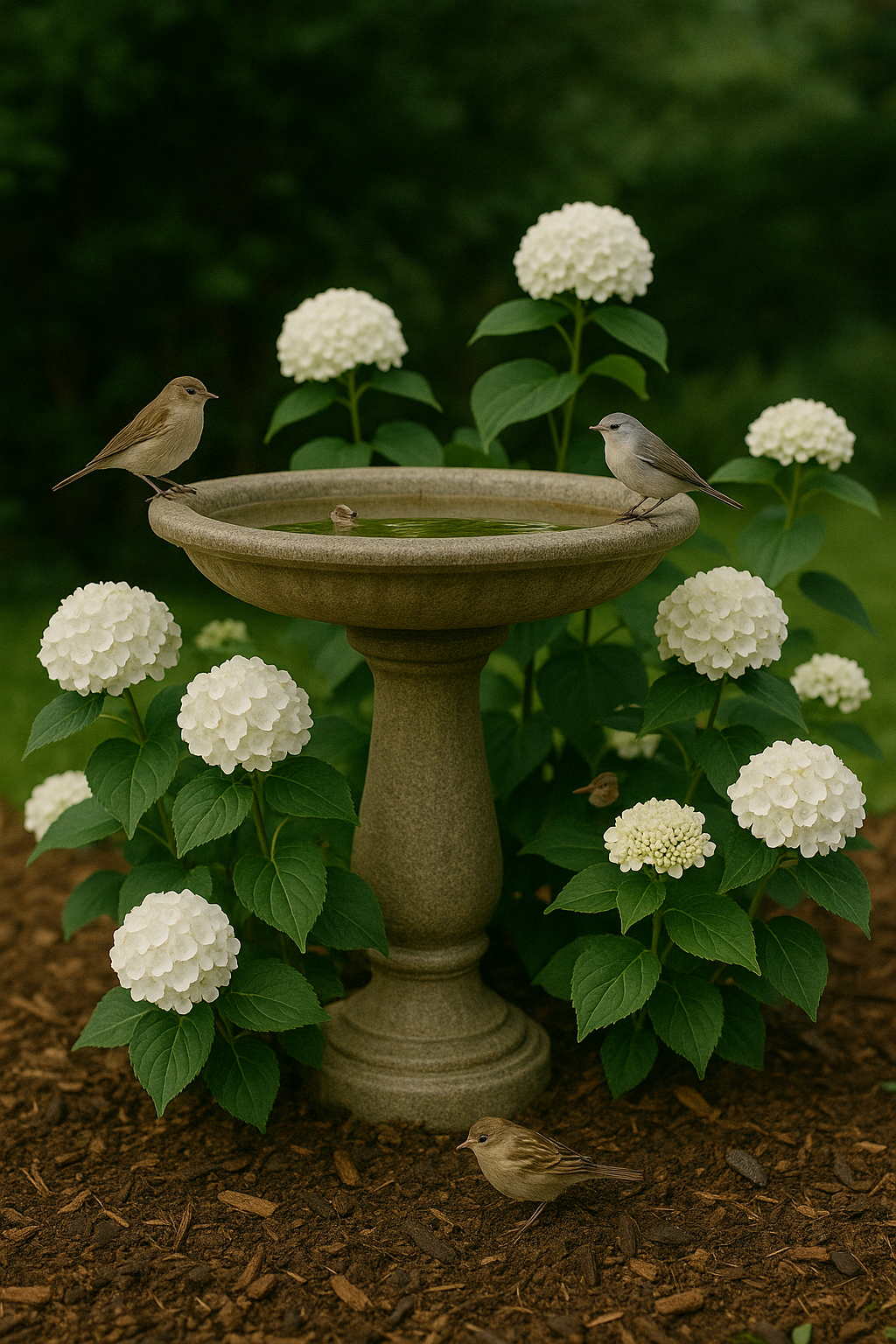
Light & Soil: Part shade is generally best for ‘Annabelle’. It can take full sun in cooler climates if kept consistently watered, but in hot climates afternoon shade is highly recommended to prevent wilting and browning. Morning sun + afternoon shade or all-day light dappled shade is ideal for plentiful blooms and healthy leaves. Plant in average, well-drained soil with consistent moisture. Hydrangeas like rich soil, so mixing compost into the planting hole is a good idea. They are not too picky about pH (unlike bigleaf hydrangeas, soil pH won’t change ‘Annabelle’s flower color since it’s always white), but they do want a moist, organic soil. Importantly, ensure drainage is adequate – ‘Annabelle’ will even tolerate clay or heavier soil better than some hydrangeas, but it still doesn’t want to sit in standing water.
Water & Care: Water regularly, as hydrangeas are thirsty, especially when in bloom. Keep soil evenly moist. In hot weather, large-leaved hydrangeas can wilt in midday sun even when soil is moist; they usually perk up in the evening, but if you see morning wilt, that’s a sign to water deeply. A layer of mulch around the root zone will help retain moisture and keep roots cool. ‘Annabelle’ blooms on new wood (the current season’s growth), so you have options with pruning. Many gardeners prune it back to about 1–2 feet tall in late winter or early spring to encourage strong new stems and larger flower clusters. This heavy pruning isn’t strictly required, but it can refresh the plant and control its size. If not pruning hard, at least remove any weak or damaged stems in spring. The stems of ‘Annabelle’ can sometimes struggle to hold up those giant flower heads, especially after rain – one trick is to encircle the plant with a short peony ring or support, or plant them in groups so they support each other. Fertilizer isn’t usually necessary if your soil is decent; too much nitrogen can actually cause fewer flowers. If desired, a light application of a balanced, slow-release fertilizer in spring can be used. With basic care, ‘Annabelle’ will reward you with an abundance of showy white blooms every summer, lighting up your garden’s shady spots with its monochrome magic.
17. Gardenia (Gardenia jasminoides)
Description: Gardenias are famous for their luscious white, rose-like flowers and incredible perfume. As evergreen shrubs, they offer year-round glossy green foliage and bloom in late spring through summer (and sometimes sporadically into fall) with intensely fragrant white blossoms. Common varieties (like ‘Cape Jasmine’) grow 3–6 feet tall depending on cultivar. Gardenias lend a tropical, romantic feel to gardens and are often grown in warm climates or in containers (so they can be protected from cold). They do require a bit of attention, but many gardeners find the effort worth it once those sweet-scented white blooms open.
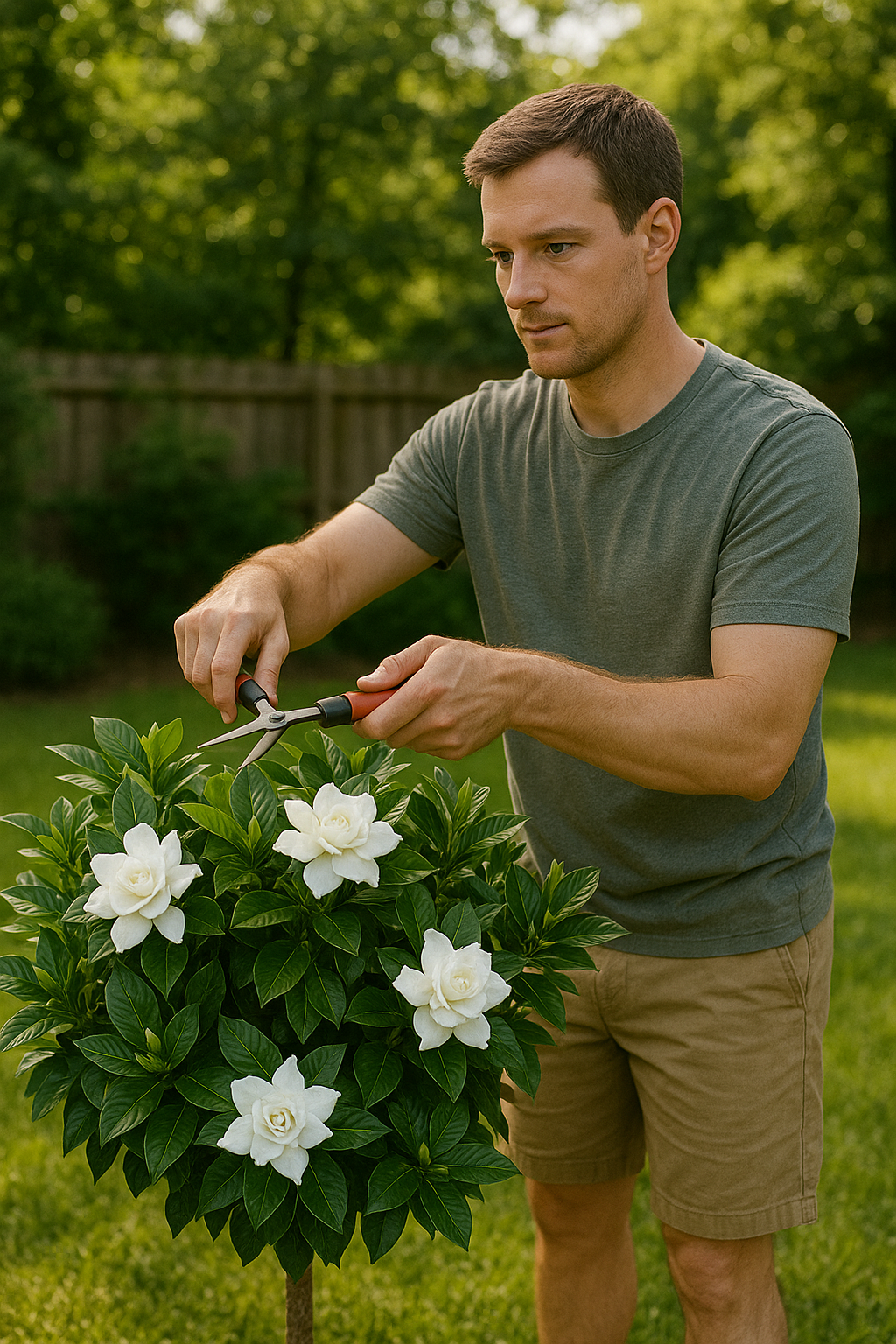
Light & Soil: Gardenias prefer light to partial shade. The ideal setup is morning sun and afternoon shade – this gives them enough light to set buds but protects them from harsh midday sun which can scorch leaves or reduce bloom time. In cooler coastal climates, they can handle more sun; in hot inland areas, more shade is beneficial. They are particular about soil: it must be acidic (pH 5.0–6.5), organically rich, and well-drained. Think azalea/rhododendron type soil – lots of peat or pine bark to provide acidity and drainage. If your soil is alkaline, you’ll need to amend it (with sulfur or use an ericaceous compost) or grow gardenia in a container with the right potting mix. Good drainage is crucial because gardenias do not tolerate waterlogged roots (they’ll develop root rot). At the same time, they like moisture – it’s a balancing act of moist yet well-draining soil. Adding organic matter helps on both fronts (improves fertility and drainage).
Water & Care: Keep soil evenly moist. Gardenias are not drought-tolerant – inconsistent watering can lead to bud drop. Water deeply when the top inch of soil feels dry, and try to use rainwater or distilled water if you have hard water, as minerals can affect them (especially in pots). Mulch around the plant to conserve moisture and keep roots cool. They also thrive in humid conditions; if you live in a dry climate, mist the leaves or place a humidifier nearby (for indoor plants). Fertilize with an acid-loving plant fertilizer (like azalea/camellia food) according to label directions during the growing season. Typically, feed lightly in spring after frost, and again 6 weeks later. Avoid over-fertilizing, which can burn roots. Gardenias benefit from minimal pruning – just trim lightly after flowering to shape if needed. Be careful not to prune in late fall or winter, as that’s when they’re setting buds for next year (many cultivars bloom on old wood). Common issues with gardenia include yellowing leaves (often due to chlorosis from alkaline soil or nutrient issues) and bud drop (usually from changes in environment or inconsistent care). With attentive care – proper soil, watering, and a little pampering – your gardenia will reward you with some of the most fragrant white flowers you can grow, making it a highlight of any monochrome or fragrance garden.
18. White Cosmos (Cosmos bipinnatus ‘Purity’)
Description: Cosmos are carefree annuals known for their long bloom time and daisy-like flowers. ‘Purity’ is a classic variety of Cosmos bipinnatus that bears pure white single flowers with yellow centers on airy, fern-like foliage. The plants reach about 3–4 feet tall and bloom from early summer until fall frost if kept deadheaded. Cosmos add a lovely, meadowy informality to gardens – they sway with the breeze and attract pollinators. White cosmos interplanted with dark foliage or black-flowered plants make a striking combination, and they’re great for cutting gardens too.
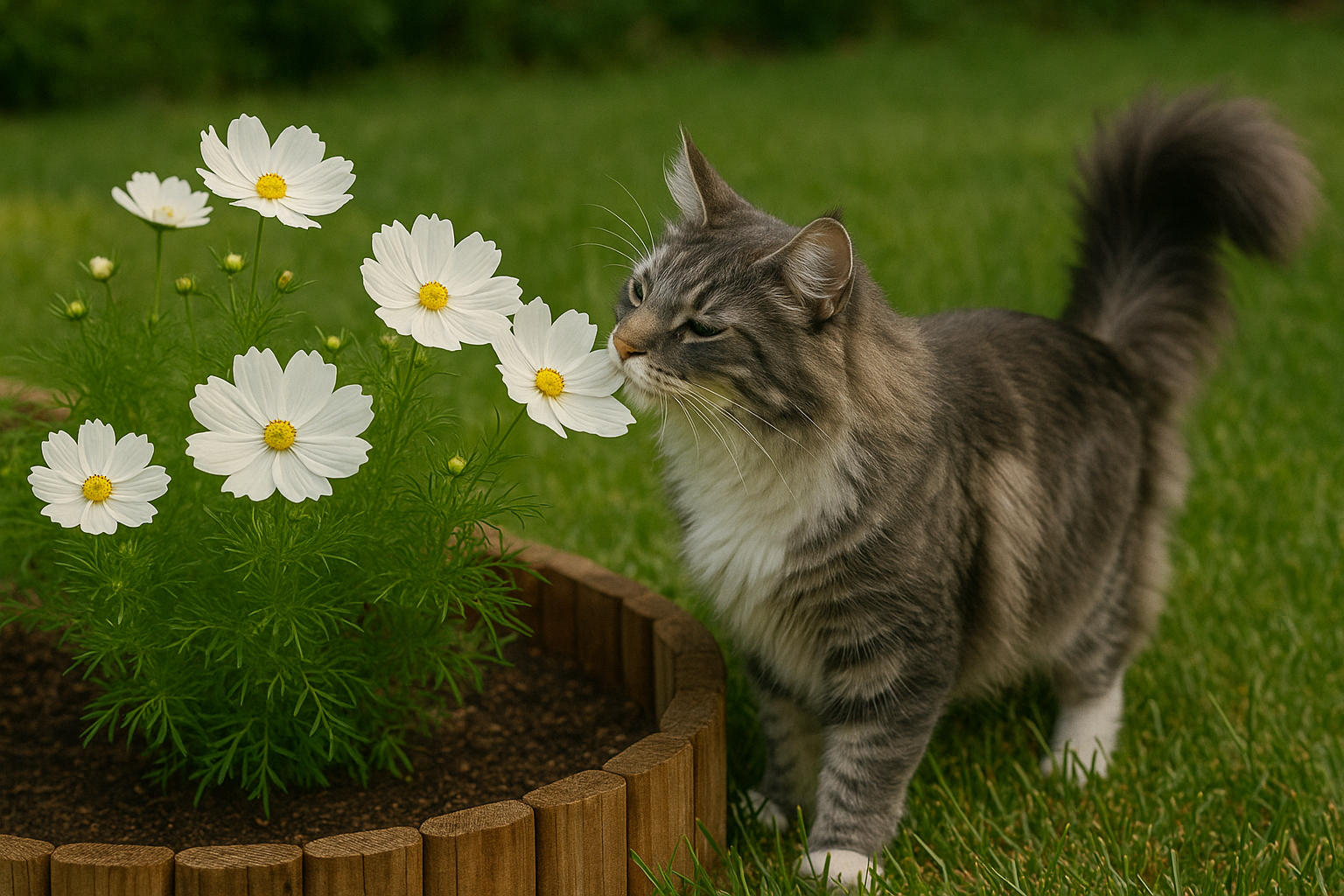
Light & Soil: Full sun is ideal for cosmos – they bloom best and stand sturdier with at least 6–8 hours of direct sun. They can tolerate part sun (minimum ~4 hours), but you’ll get fewer blooms and taller, leggier plants. Cosmos are wonderfully undemanding about soil. In fact, they prefer average or even poor, well-drained soil. Avoid very rich soil or heavy fertilization, as that will cause lots of foliage and fewer flowers. They do well in neutral to slightly alkaline soil (pH ~6.5–7.5). The key is that the soil be well-drained – cosmos hate sitting in mud. They are quite drought-tolerant once established and even handle sandy or dry soils adequately.
Water & Care: Water newly planted cosmos regularly until you see steady growth. Once established, cosmos can be left alone in all but the driest conditions – they truly thrive on some neglect. In normal weather, they usually get enough moisture from rainfall. If you encounter a prolonged drought or extreme heat, give them a deep watering to keep them happy (they will survive drought but bloom better with a drink now and then). Do not over-water; too much water + rich soil can make them lanky. They generally don’t need fertilizer – again, over-feeding reduces flowering. Simply sow or transplant them into the garden after the last frost, water in, and watch them grow. Deadheading spent flowers will greatly prolong bloom – if you continually remove the old flowers, cosmos will keep pumping out new buds for months. You can also succession-sow a second batch in early summer for late blooms. Taller cosmos might need a little staking or support if in a windy area, though their wiry stems are surprisingly resilient. Overall, cosmos are one of the easiest annuals: plant them in sun, give a little water, and enjoy waves of white blooms that lighten up your garden all summer. They’re perfect for a black and white garden because their bright white flowers contrast so nicely with dark blooms or foliage.
19. White Tulip (Tulipa – white varieties like ‘White Emperor’ or ‘Mount Tacoma’)
Description: White tulips bring a fresh, clean elegance to the spring garden. There are many white varieties: ‘White Emperor’ (aka ‘Purissima’) is a lovely early blooming tulip with goblet-shaped white flowers; ‘Mount Tacoma’ is a double late tulip that looks like a white peony; ‘White Triumphator’ is a graceful lily-flowered type; and ‘Ice Princess’ or ‘Snow Lady’ are other options. You can even get mixes of various white tulips for a textured monochrome display. Tulips, of course, are spring-blooming bulbs planted in fall. A bed of mixed white tulips in bloom is a show of its own, or use them to complement dark tulips like Queen of Night for high contrast.
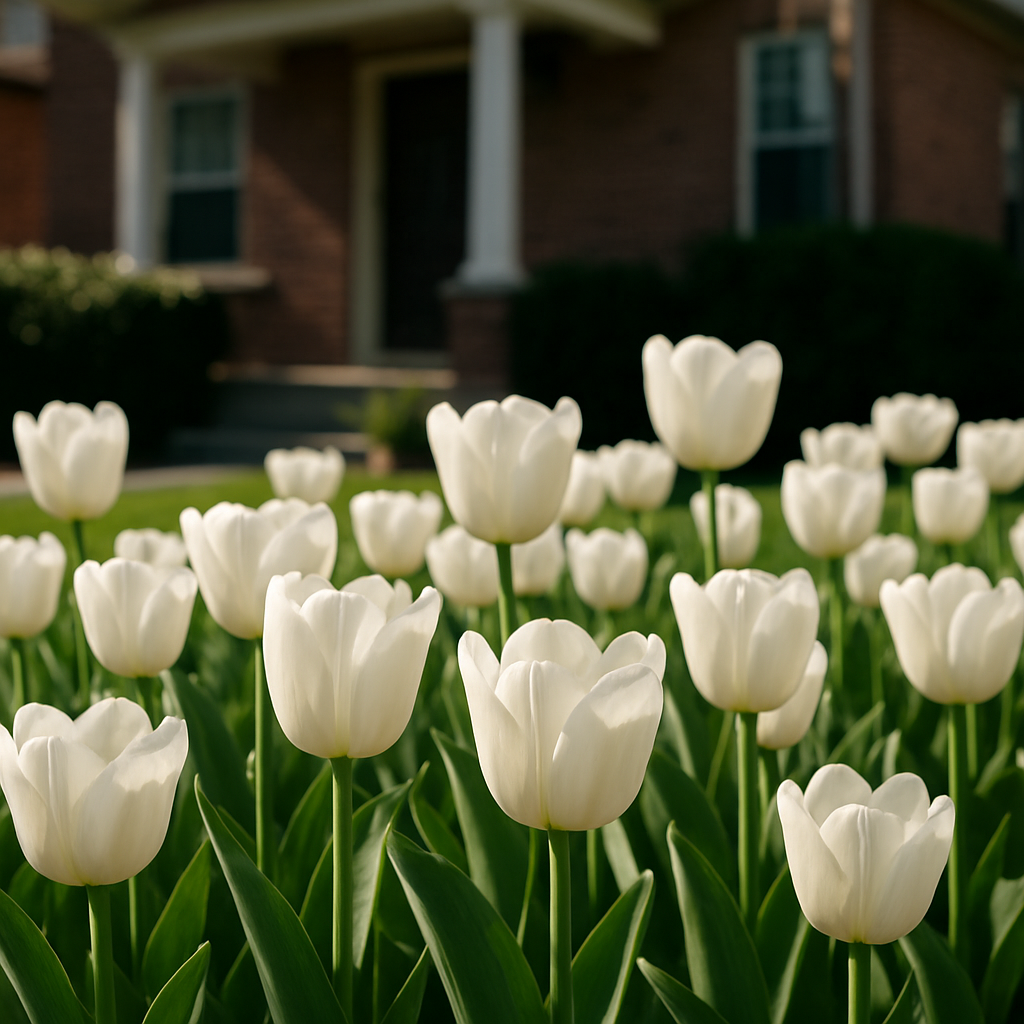
Light & Soil: Plant tulips in full sun (they’ll tolerate light shade, but best bloom and sturdiness is in sun). They prefer well-drained soil that’s rich in organic matter. Sandy or loamy soils are great, especially with added compost. If you have heavy clay, definitely amend with organic matter and consider slightly shallower planting or raised beds. Tulip bulbs can easily rot in waterlogged soil, so good drainage is essential. In fact, many people in wet climates plant tulips in beds that shed water or even dig them up after bloom to avoid summer rot.
Planting & Care: Plant white tulip bulbs in the fall, once soil cools (around 6–8 weeks before hard frost). Depth: about 2–3 times the bulb’s height, roughly 4–6 inches deep for most tulip bulbs. Place bulbs pointed side up, and space them a few inches apart (or closer for a dense display). After planting, water them in to help settle the soil. Through winter, they need no care. Come spring, as they emerge, you can water if spring rainfall is scant – they like consistent moisture during their growth and bloom period. After flowering, remove spent blooms to prevent seed formation, but do not cut the foliage until it yellows and withers. The leaves feed the bulb for next year. In many regions, hybrid tulips are best treated as annuals (they tend to have diminished blooms in subsequent years). Feel free to plant fresh bulbs each fall for a guaranteed show. If you do try to perennialize them, ensure they get a hot, dry summer bake (you can even lift them and store them after foliage dies, replanting in fall). Tulips also appreciate a bit of bulb fertilizer or bone meal in fall at planting time for added nutrients. With minimal effort, your white tulips will burst forth in spring, providing a dazzling display of snowy blooms that herald the new gardening season.
20. White Bearded Iris (Iris germanica – white cultivars like ‘Immortality’)
Description: White irises bring a touch of sophistication with their pristine blooms. Many bearded iris cultivars come in white or near-white – for example, ‘Immortality’ is a pure white reblooming iris (blooms in spring and again in late summer/fall), and ‘Iceberg’ (Iris germanica) or ‘Snow Swan’ are other elegant whites. The flowers have the classic iris form with ruffled falls and standards, and that golden or white “beard” on the falls. They stand about 2–3 feet tall. White irises are excellent in a border and combine well with darker blooms or against a backdrop of green shrubs.
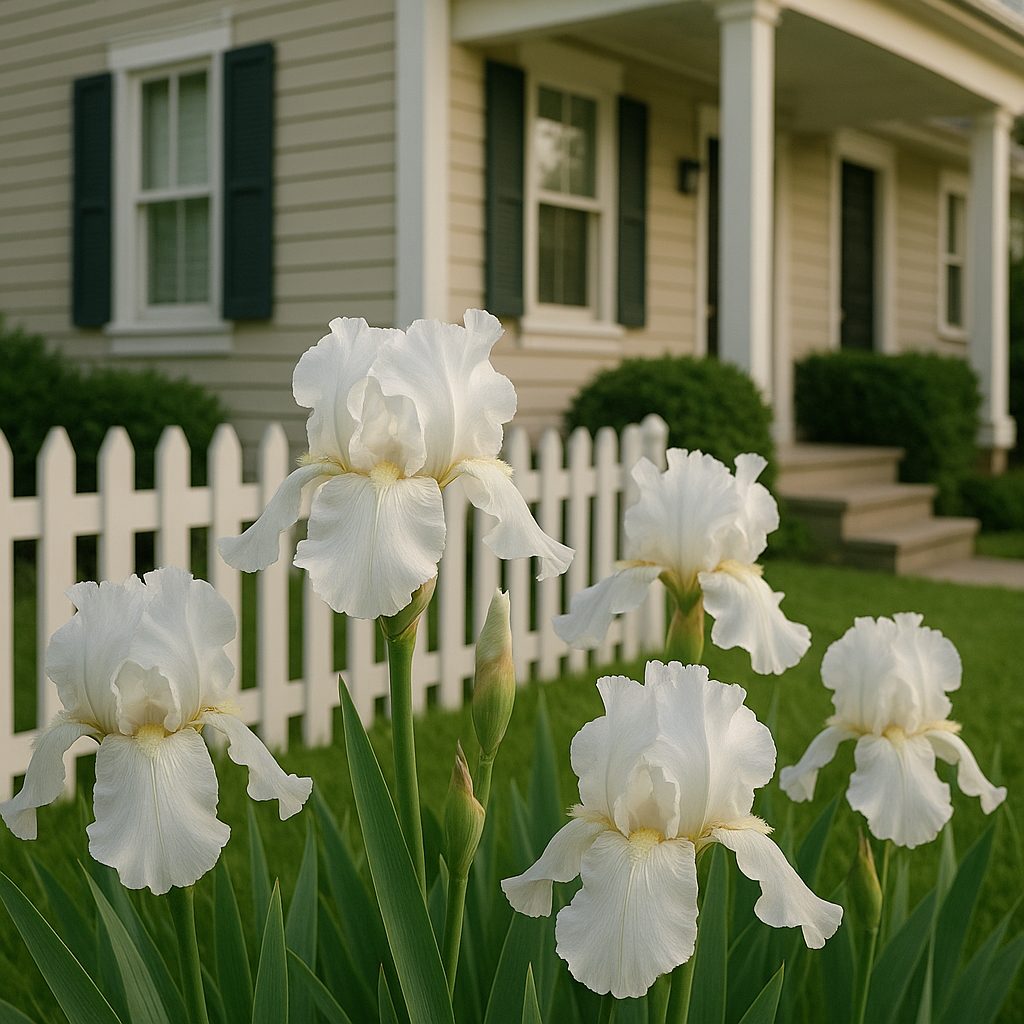
Light & Soil: As with the black iris earlier, full sun is ideal for bearded irises to bloom well. They can handle a half-day of sun, but anything less and you’ll get fewer or no flowers. Plant in well-drained soil (absolutely critical), and if possible, on the leaner side – overly rich or heavily mulched soil can lead to rot around the rhizomes. Irises like neutral to slightly alkaline soil, but are adaptable. If your garden soil is heavy clay or tends to stay wet, consider creating a raised mound or ridge and plant the iris rhizomes slightly exposed (tops at or just above soil level) to keep them dry.
Water & Care: Moderate water needs. Water the white iris when the topsoil is dry – generally, they need moisture in spring during active growth and bloom. After flowering, they enter a more dormant phase in summer and actually prefer it on the drier side (excess water in hot weather can invite rot). If you have a rainy summer climate, ensure good air flow and maybe even cover the rhizome area with gravel for evaporation. These irises are low-maintenance: remove the spent flower stalks after bloom, and in fall you can trim back the foliage fans to about 6 inches to tidy up (especially if foliage gets leaf spot). Every few years, if the clump becomes crowded (typically 3–5 years), lift and divide the rhizomes in late summer. Replant the vigorous outer pieces and discard old center sections. This revitalizes the plant and encourages continued flowering. When dividing or planting new irises, remember not to bury the rhizome deeply – they like their backs to get a touch of sun. A bonus about many white irises like ‘Immortality’ is the rebloom – given good conditions (sun, some feeding and water), ‘Immortality’ can send up a second flush of blooms in late summer. To encourage this, a light fertilizer application right after the spring bloom can help fuel the re-bloom. With their serene white blooms and tough nature, white irises are a welcome perennial in any garden, adding vertical interest and a classical charm.
21. ‘Casa Blanca’ Lily (Lilium Oriental hybrid)
Description: ‘Casa Blanca’ is a renowned white Oriental lily prized for its large, pure white, star-shaped flowers and powerful fragrance. Each stem can carry numerous blooms (often 6–8 or more), and they open in mid to late summer. The plant reaches about 3–4 feet tall. As a group, Oriental lilies are known for thriving in the sun with big, perfumed blooms; ‘Casa Blanca’ is often considered one of the most beautiful white lilies for gardens or bouquets. It’s a fantastic choice to incorporate white into a monochromatic scheme, and the scent in the evenings is an added bonus.

Light & Soil: Plant ‘Casa Blanca’ in full sun to part shade. In cooler regions, full sun (6+ hours) produces stout stems and lots of flowers. In hotter climates, afternoon shade is recommended to help the blooms last and to prevent scorching of leaves. An ideal phrase often used is “lilies like their head in the sun and feet in the shade,” meaning you can allow the upper part of the plant to get sun but keep the roots cool by shading them with lower plants or mulch. Soil should be moist, well-drained, and rich. Lilies do best in loamy soil enriched with organic matter. They dislike heavy waterlogged clay. Ensure your site has good drainage, especially in winter. Oriental lilies prefer slightly acidic to neutral soil.
Planting & Water: Plant the bulbs in spring or fall (fall is often preferred for Oriental lilies). Depth: about 6 inches deep for large bulbs, and space them 6–12 inches apart. After planting, water them in. During the growing season, keep soil evenly moist – lilies need consistent moisture but not sogginess. Water whenever the top couple of inches dry out, aiming to soak the root zone. Mulch over the bulb area helps retain moisture and keep the soil cool.
Care Tips: As the lilies grow, you may need to stake them, especially in windy areas, since the heavy blooms can make the stems top-heavy (though ‘Casa Blanca’ has pretty sturdy stems). Feeding with a balanced fertilizer or a bloom-boost formula in spring as growth starts can enhance flowering. Once blooming, remove flowers as they fade (so the plant doesn’t waste energy on seed production). After the plant finishes blooming, leave the stalks and leaves until they yellow and die back – like other bulbs, they need that time to recharge the bulb. In late fall or winter, you can then cut the dead stems at ground level. ‘Casa Blanca’ is hardy in USDA zones 4–8. In very cold zones, a layer of mulch over winter can protect bulbs. If you’ve planted in a decent spot, lilies usually come back year after year and even multiply. They typically do not need dividing for several years. Enjoy cutting a few for indoor arrangements – the scent will fill a room (just be cautious with the pollen as it can stain fabrics). With ‘Casa Blanca’ lilies, your garden will have an element of pure white luxury each summer, both visually and in fragrance.
22. White Peony (Paeonia lactiflora e.g. ‘Festiva Maxima’ or ‘Duchesse de Nemours’)
Description: Peonies are beloved perennials for their lush, extravagant flowers in late spring. Many classic peonies are white: ‘Festiva Maxima’ has huge white double blooms with an occasional red fleck at the center, and a wonderful fragrance (introduced in 1851 and still a garden staple!). ‘Duchesse de Nemours’ is another heirloom white peony with creamy-white petals and a strong perfume. These herbaceous peonies form bushy plants ~3 feet tall/wide. They bloom in late spring (around May/June), then the glossy green foliage remains through summer. A white peony in bloom is a highlight of the spring garden, and the flowers are excellent for cutting.
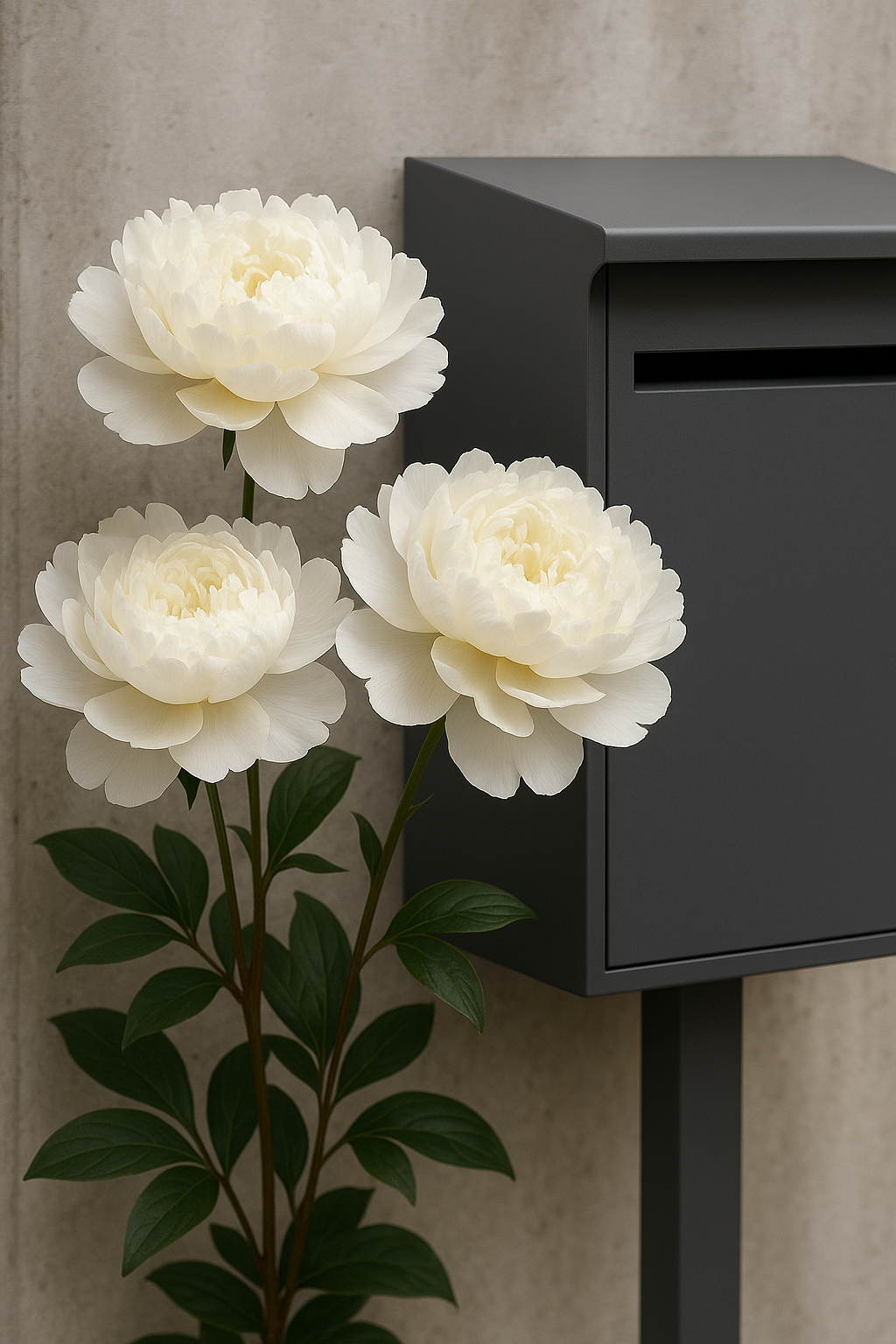
Light & Soil: Plant peonies in full sun for best flowering – they can handle some light shade, but too much shade will result in few or no blooms. In hot climates, a bit of afternoon shade is fine (and can help the flowers last a bit longer), but generally they want a good dose of sun. Use rich, fertile, well-drained soil. Before planting, dig in plenty of compost or well-rotted manure; peonies are heavy feeders and will happily live for decades in the same spot if the soil is prepared well. They like a neutral soil pH around 6.5–7.0. Drainage is important because although peonies enjoy moisture, the tuberous roots can rot in waterlogged ground. If you have clay soil, amend with organic matter and ensure the site doesn’t collect standing water.
Water & Care: Water peonies deeply during growth and blooming – they need consistent moisture in spring when they’re sprouting and setting buds. Once established, peonies are fairly drought-tolerant, but lack of water can reduce bloom size/quantity. Typically, watering once a week (providing ~1 inch) is sufficient unless it’s very hot or dry. Mulch around the plant to keep the soil cool and moist, but keep mulch a few inches away from the crowns to prevent rot. Planting depth is crucial for peonies: the “eyes” (buds) on the root should be only about 1–2 inches below the soil surface when planting. If planted too deep, they may not bloom. After planting, be patient – peonies often take 2–3 years to settle in and produce lots of flowers (but then they bloom for decades). Staking or support rings are often needed for peonies, especially double varieties whose heavy blooms tend to flop in rain. Place a ring or peony cage over the plant early in spring so it grows through it. Once peonies finish blooming, snip off the faded flowers (to avoid seed formation). The bushy foliage will continue to look nice through summer and feeds the roots for next year. In autumn after frost, cut the foliage to the ground and remove it (this helps reduce the chance of disease overwintering). Peonies are quite cold-hardy (down to zone 3) and actually require a winter chill to bloom well (they need that dormant cold period). They generally do not need to be divided for many years – only divide if you want to propagate more plants, or if the clump becomes too large for its space (they actually bloom better when somewhat crowded). With minimal maintenance, a white peony like ‘Festiva Maxima’ will grace your garden with massive, fragrant white blooms each year – a true delight and a staple of white perennial flowers in traditional gardens.
23. White Phlox (Phlox paniculata ‘David’)
Description: Garden phlox ‘David’ is a standout perennial noted for its pure white, sweetly fragrant flower clusters and strong mildew resistance. It forms upright clumps about 3–4 feet tall, blooming in mid to late summer (July through September). The dense conical clusters of white blooms are butterfly magnets and excellent for cutting. In a border, ‘David’ adds height and a cooling wash of white, pairing nicely with darker flowers or green foliage. It’s also an American native cultivar, derived from our native Phlox paniculata.
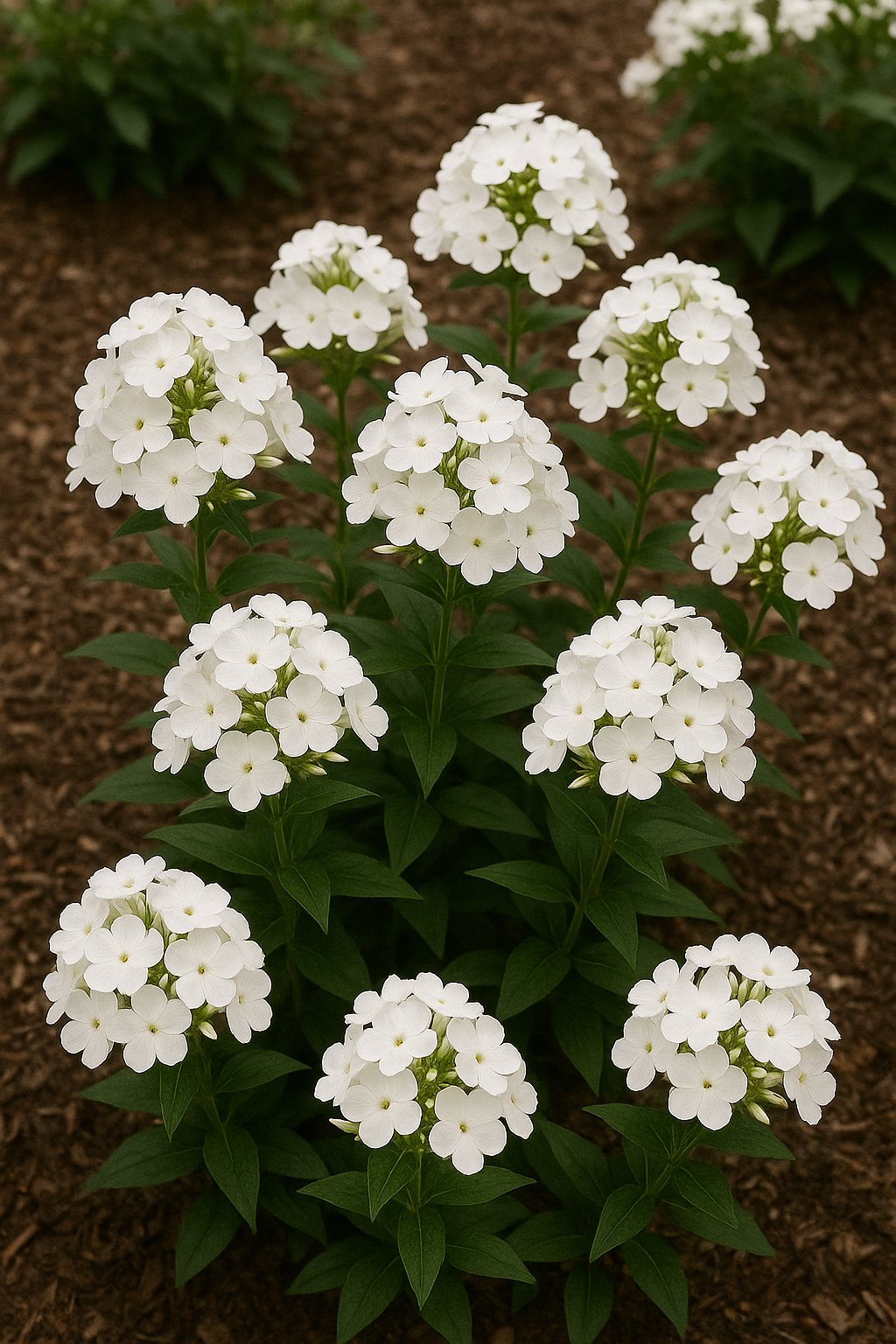
Light & Soil: Full sun is recommended for phlox, as it promotes sturdy growth and more flowers. It will grow in part shade (and might even appreciate some afternoon shade in very hot areas), but too much shade can lead to leggy stems and more mildew issues. Plant in moderately fertile, well-drained soil with consistent moisture. Phlox likes rich, organic soil – mixing compost into the planting area is beneficial. It also prefers not to dry out, so soil with some water-holding capacity (but that still drains well) is best. A loamy soil enriched with organic matter is ideal. Good air circulation around the plant is key to preventing powdery mildew. So avoid crowding phlox; give ‘David’ some space from its neighbors.
Water & Care: Keep phlox evenly moist. Water regularly so that the soil stays consistently damp (but not swampy). In dry spells, phlox will be prone to mildew and might drop lower leaves, so don’t let it suffer drought. It’s said ‘David’ is mildew-resistant, which is true relative to older phlox, but no phlox is totally immune – proper spacing, sun, and watering at the base (avoid wetting leaves) all help keep foliage healthy. If you notice any mildew, removing affected foliage and improving air flow helps. Deadhead the spent flower clusters to encourage possibly a bit of rebloom or at least to keep it looking tidy. Sometimes phlox will send up some side shoots with new flowers after the main head is cut. In fall, once it’s done blooming and foliage is declining, cut the stems down to the ground. Since diseases like mildew can overwinter, it’s wise to clean up all phlox debris from the garden and dispose of it. Every few years, you can divide phlox in spring or fall if the clump gets too dense (or if you want to propagate more). Also, a tip: applying a summer mulch around phlox can help keep the root zone cool and moist, which the plant appreciates. With a little care, phlox ‘David’ will reward you with masses of snowy white blooms and fill your garden with a lovely fragrance on summer evenings. It’s truly one of the white blooming perennials that earns its keep, year after year.
24. Baby’s Breath (Gypsophila paniculata)
Description: The airy clouds of baby’s breath are a staple in floral arrangements, but they’re also wonderful in the garden. This perennial produces masses of tiny white flowers on very fine, branched stems, giving a misty, cloud-like effect. It forms a mound about 2–3 feet tall and wide. Once established, a baby’s breath clump in full bloom looks like a soft white haze – a perfect complement to bolder flowers. Varieties include single-flowered forms and double ones (with fuller little blooms). Baby’s breath is great in rock gardens, cottage gardens, or any well-drained sunny spot where you want a light, delicate texture.

Light & Soil: Full sun is required for good bloom and compact growth. In less than full sun, it tends to flop and bloom sparsely. When it comes to soil, good drainage is absolutely critical. Gypsophila translates to “lime-loving,” and indeed baby’s breath prefers neutral to alkaline, well-drained soil (not acidic). If your soil is acidic, you may need to add lime to raise the pH. It also doesn’t like heavy clay or overly rich soil. In fact, this plant thrives in rather poor, dry, sandy or rocky soil, as long as it doesn’t stay wet. If planting in heavier soil, consider a raised bed or adding grit to improve drainage. Basically, treat it a bit mean – that means no excessive fertilizer either, or it can get floppy.
Water & Care: Water sparingly once established. Baby’s breath is quite drought-tolerant and actually prefers drier soil conditions. After planting, water to get it established (the first few weeks). But once you see new growth and the plant has settled, you can ease off. It has deep roots and will seek out moisture. Overwatering or constantly moist soil often spells death for this plant (root rot). One thing to note: newly planted baby’s breath might sulk or even die back in very hot, wet weather – but if the roots are alive, it often returns next season when conditions are better. Pruning: After the main flush of blooms, you can shear the plant back by about half to encourage a second bloom later in the season. Also, cutting it back prevents excessive self-seeding (it can seed around, though not invasively in most cultivated gardens). It’s a good idea to rejuvenate baby’s breath every few years by trimming hard or dividing, as it can get woody in the center. That said, they don’t love being moved – they have long taproots and can be temperamental to transplant. So pick a good permanent spot to begin with. If you notice any stems flopping, you can prop them gently or interplant baby’s breath among sturdier companions that hold it up. But in the right conditions (sunny, dry, alkaline), it should form an upright mound. Baby’s breath is also deer and rabbit resistant and generally pest-free. Just give it sun and dry feet, and it will decorate your garden with its gossamer white sprays. It truly adds a light, airy white element that softens any planting scheme.
25. White Coneflower (Echinacea purpurea ‘White Swan’)
Description: Coneflowers are hardy perennials native to North America, traditionally purple, but ‘White Swan’ is a beautiful white-flowering form. It features large daisy-like blooms with pure white petals (ray florets) surrounding a coppery-orange central cone. Plants reach about 2–3 feet in height. These bloom from early/mid summer into fall. White Swan echinacea brings a sturdy, easy-care presence to the garden – lovely in wildflower, prairie-style, or cottage gardens. They provide nectar for butterflies and later seeds for songbirds if you leave spent blooms on. Their clean white petals mix well with just about anything, including the darker “black” plants on this list.
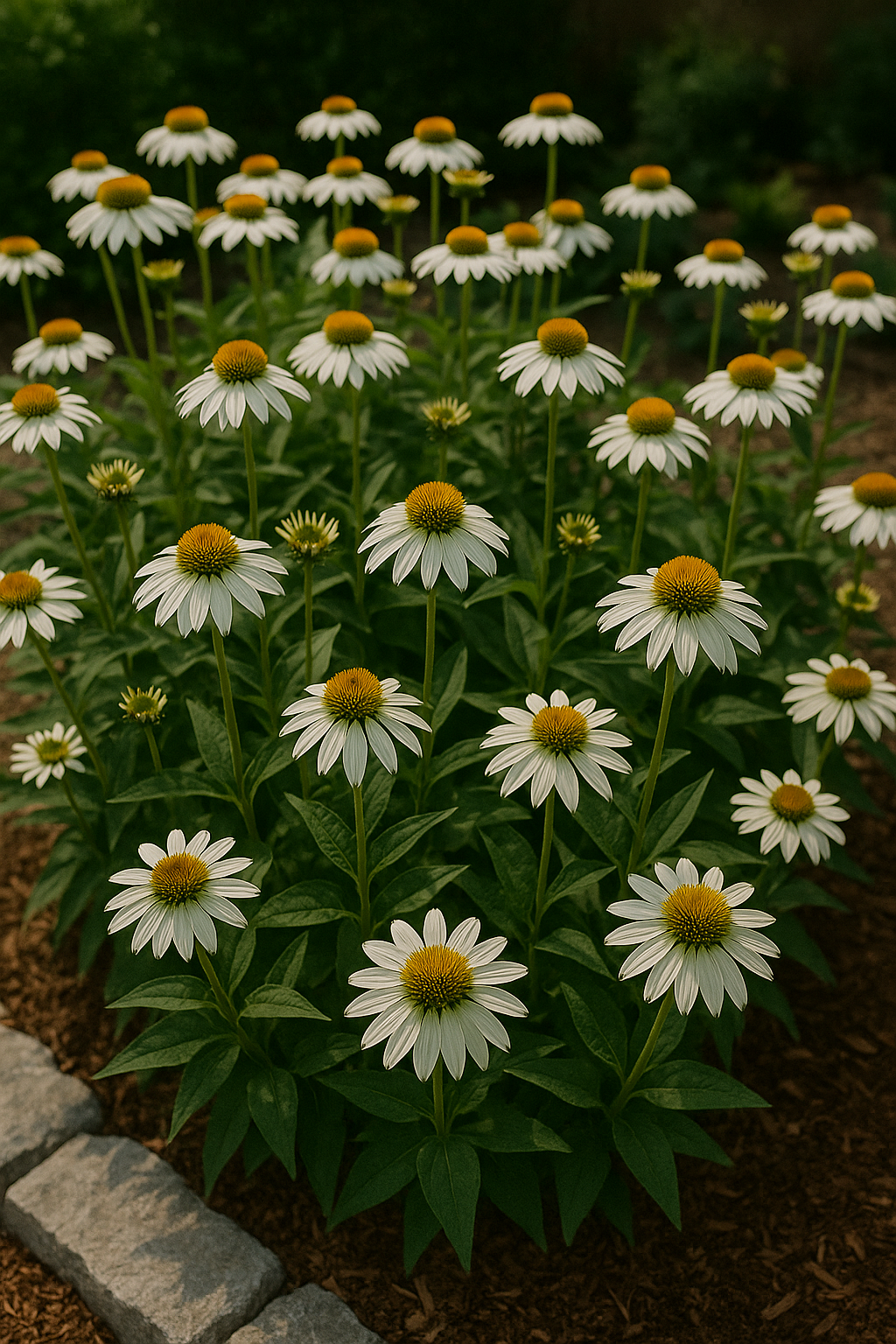
Light & Soil: Full sun is optimal for coneflowers, though they can manage with a bit of light shade (they’ll just stretch more). At least 6 hours of sun keeps them blooming and upright. They are not fussy about soil: average garden soil that’s well-drained is perfect. In fact, echinacea is quite tolerant of drought and heat once established. They prefer a somewhat lean soil – overly rich soil can lead to lush foliage but fewer flowers and potentially floppier growth. They handle clay or rocky soils fine as long as water doesn’t stand. Essentially, if you have a spot that other perennials struggle in due to heat or dryness, try coneflower there.
Water & Care: Water regularly the first season to get the plant established. After that, coneflowers only need occasional watering – they are prairie natives and can thrive on low water (their deep taproots make them quite self-sufficient). They will, however, flower more profusely with moderate watering during prolonged drought, so it’s beneficial to give them a drink during extreme dry spells. Generally, though, they are low-maintenance and “thrive on neglect” as some gardeners say. They don’t need much fertilizer; too much can even reduce their hardiness. A compost top-dressing in spring is plenty. One care tip: to prolong the bloom season, you can deadhead some of the spent flowers (cut the stem just above a set of leaves). This can encourage additional blooms later. However, consider leaving the last batch of spent blooms in the fall – the prominent dark cones look attractive in winter and birds (like goldfinches) will perch on them to eat the seeds. In late fall or very early spring, you can cut down the dead stems. Every 3–4 years, if the clump gets very large, you can divide it in spring, but coneflowers often bloom best when left untouched. They are generally pest and disease free, and even deer usually leave them alone (the leaves are a bit rough and aromatic). ‘White Swan’ coneflower will reliably come back each year (hardy to zone 3) and is a fantastic perennial to anchor the white section of a monochrome garden – combining toughness with beauty.
Conclusion
Creating a black-and-white theme in your garden is not only possible but incredibly rewarding. By combining monochrome garden plants – from velvety black blooms to radiant white flowers – you get a sophisticated contrast that turns heads. We’ve covered annuals and perennials, sun lovers and shade dwellers, easy cottage flowers and a few exotic collectibles. Mix and match these 25 selections to suit your space: tuck black flowering annuals like petunias or cosmos into pots and borders for instant drama, and plant white blooming perennials like Shasta daisies, phlox, and peonies for year-after-year reliability.
Remember the key care tips: give each plant the right light, soil, and water as noted, and they’ll largely take care of themselves. As you plan your monochromatic masterpiece, don’t be afraid to play with textures and bloom times – the green foliage of these plants will provide a unifying backdrop (as Vita Sackville-West found in her famous White Garden, green is the secret extra color that makes white gardens shine). With a little DIY spirit and the information here, you can cultivate a stunning black-and-white garden that showcases the beauty of contrast. Happy gardening, and enjoy the elegance this palette brings to your outdoor sanctuary!
